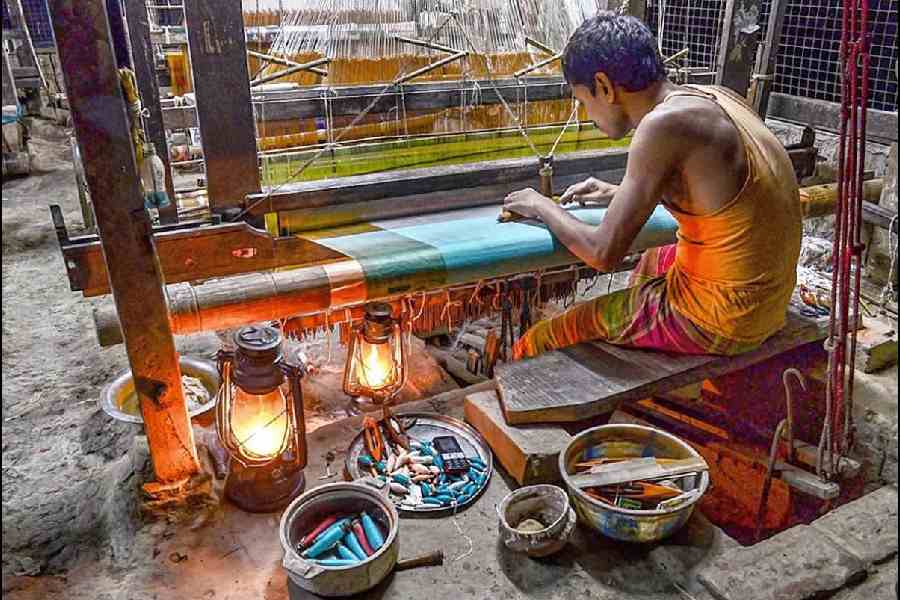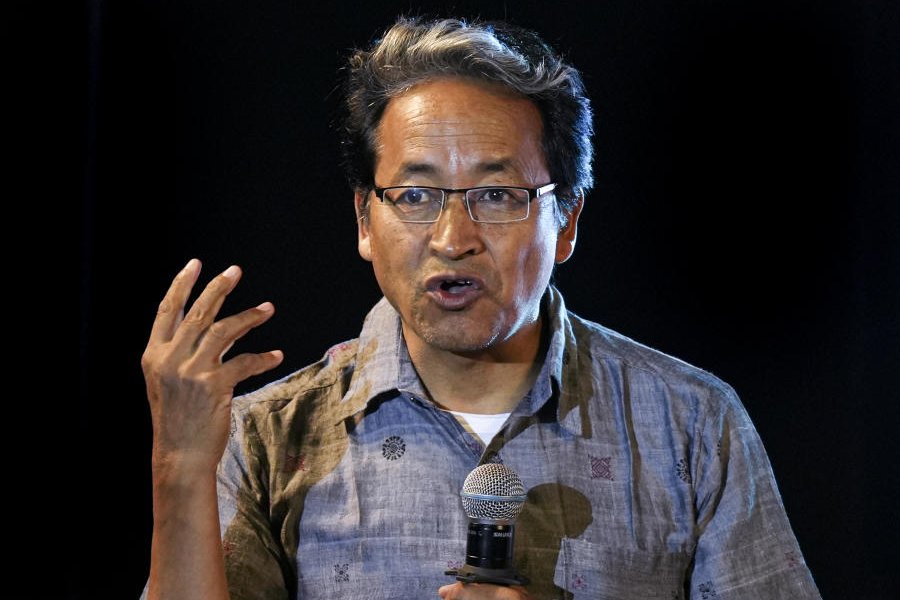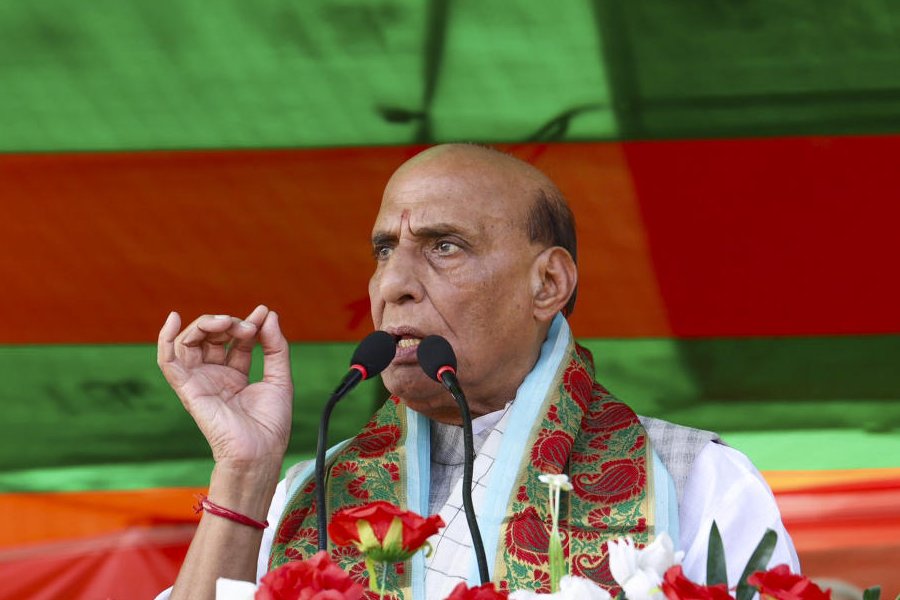A kani shawl can take over a year to make. Its intricate design is not mapped on paper but guided by taalim, an oral tradition passed down through generations in the Kashmir Valley. Dozens of slender, eyeless bobbins called kanis build the motif, thread by thread. The result is an object steeped in time, skill, and cultural meaning. In the Mughal court, such shawls signified rank and were bestowed as part of a khilat, a robe of honour to favoured courtiers. They adorned Empress Josephine, the wife of Napoleon Bonaparte, who helped spread the fashion among European elites. An 1805 painting by François Pascal Gérard, now in the Belvedere Palace in Vienna, shows a noblewoman in a white muslin gown draped with an orange kani shawl — capturing how the artefact became a marker of European sophistication. In time, the design was imitated in Paisley, Scotland, where factories produced machine-woven versions on Jacquard looms, and the teardrop motif became known as ‘Paisley’.
And yet, despite their artistry and heritage, most kani weavers are struggling to eke out a living today. The paradox is sharp: exquisite making, invisible makers. This story plays out across India — among the block printers of Rajasthan, the jamdani weavers of Bengal, the zardozi embroiderers of Lucknow — where some of the world’s most refined textile traditions survive on the economic margins.
India is home to the largest population of craft artisans in the world; yet their labour is rarely transformed into storied brands that allow them to share in the cultural and the commercial value they create. Our nation’s aesthetic intelligence remains disconnected from its economic structures. Craft traditions endure in technique, but they falter in innovation, visibility, and reward.
Mahatma Gandhi placed artisans at the heart of India’s moral economy, elevating khadi as the fabric of freedom. Yet, as with farmers, symbolic celebration rarely translated into commercial empowerment. Artisans were cast as icons of politics and charity rather than as businesspeople, their modest earnings leaving no room to invest in innovation, brand identity, or market access. The post-Independence network of State emporiums and NGO-run cooperatives preserved heritage but failed to adapt craft to contemporary aspirations, or to position it as a marker of status and taste. By contrast, European craftspeople working in nineteenth-century India — such as C. Lazarus, whose billiards tables and fine furniture graced British estates and Calcutta clubs, and Hamilton, the silversmith, whose work adorned elite drawing rooms — turned skill into enduring commercial brands, pairing creative mastery with market reach in a way Indian artisans were neither enabled nor encouraged to do.
Globally, luxury brands have repositioned craft traditions and built powerful narratives around them. Groups like LVMH and Richemont have acquired ateliers, such as Parisian embroidery houses, Venetian glassmakers, and Tuscan leather studios, not only for their technical mastery but also for the stories embedded in their making. These studios are run with efficiency to produce high-margin, limited-edition pieces, but their names, history, and creative identity are preserved. The atelier is seen as the author of the work. In India, by contrast, craft is often stripped of its authorship, and the artisan is left to earn a living in anonymity.
At key moments, Indian craft has been reimagined with coherence and conviction. Anokhi in Jaipur revived block printing in the 1970s by giving it new life. Historically, block prints adorned jajams, turbans, and everyday garments across Rajasthan. In Balotra, the placement of a motif or the width of a ghagra border signalled caste and social identity. A red border with yellow piping could indicate marital status. Patterns like phooli, gainda, chameli, and trifuli formed a semiotics deeply understood in their communities. In post-Independence India, that language was fading. Mill-made polyester had become the fabric of modernity: cheap, washable, and free of social markers. As women moved beyond their villages for work and education, many no longer wished to wear their identity on their sleeve. Block-printed cotton, once rich with symbolism, was dismissed as outdated.
Anokhi reversed the decline by reimagining block prints for the bohemian West. Its prints were shaped into kaftans, bell-bottoms and wrap skirts that found a second life in the global counterculture and were introduced at Liberty of London, featured in Vogue, and then became sensational through Monsoon and Accessorize. What had once been a tightly coded language of caste and marriage became, ironically, a symbol of cosmopolitan ease and rebellion. Anokhi made a traditional Indian craft technique aspirational. Fabindia built the infrastructure to scale craft work. Founded in 1960 by John Bissell, a Macy’s-trained buyer, Fabindia linked rural artisans with urban markets and pioneered ready-made, standardised craft objects, beginning with the khadi-kurta. It created systems and processes for dyeing, stitching, inventory, and sizing, ensuring that the supply chain was robust and repeatable. In doing so, it offered a template for later craft-based enterprises, from senior management structures to craft cluster organisation.
A similar revival is underway in Bengal. The balaposh, a luxurious quilt once used by the Nawabs of Murshidabad, had nearly disappeared. Its making is exquisite: attar-scented cotton between two silk layers, stitched only at the edges. Only one master artisan, Sakhawat Hussain Khan, retained this knowledge. With the support of Biswa Bangla, the balaposh has returned. Artisans like Rumi Khatun are now transforming it into a living heirloom, an object with over 300 years of history folded into its fibres.
Other contemporary studios are redefining the relationship between heritage and innovation. Chanakya, the Mumbai-based embroidery atelier, works with couture houses like Christian Dior, bringing traditional Indian embroidery to the highest levels of global fashion. It also runs the Chanakya School of Craft, training young women in heritage techniques while encouraging creative authorship. Raw Mango, founded by Sanjay Garg, has reimagined handloom. Rather than presenting chanderi or benarasi as ethnic nostalgia, Raw Mango renders them bold, minimal, and modern. Its campaigns feature artisans wearing their own creations, reclaiming not only the authorship but also the pride of craft.
Platforms like The India Story in Calcutta help frame these movements within a wider cultural conversation. By curating exhibitions and storytelling spaces where weavers, designers, and audiences interact, they show that craft is not just an object, but a bridge between heritage and aspiration. The aesthetic sophistication of India’s villages is thus recognised.
These are still isolated ventures, but they can be a model for a craft-led economy that powers a creative industry in which artisans are stakeholders. This requires more than nostalgic admiration. It needs infrastructure, design institutes focused on heritage techniques, digital tools to connect rural makers to global markets, legal protections for geographical indicators, and capital that values skill over scale.
Above all, it needs patronage. The journey from artisan to businessperson begins at home. It starts when we choose to use local craft in our daily lives — a finely woven madur on the floor, a piece of handmade furniture made of local wood, a tailored handloom kurta or dress — and value the skill and the authorship behind them. Local patronage builds the confidence and the capacity for artisans to compete in larger markets. From there, global opportunities can follow, transforming subsistence work into thriving enterprises. If an increasingly affluent India uses its purchasing power in this way, it can help realise the dreams of millions of artisans, turning craft from a livelihood into a legacy.
The task before us is simple but urgent: to recognise the wealth of craftsmanship we hold in villages, workshops, and hands, and to ensure that the artisan is not only the maker but also the storyteller and the beneficiary. In doing so, we may rediscover something rare: an economy that remembers its culture, and a culture that sustains its people.
Rudra Chatterjee is Chairman of Obeetee, Managing Director of Luxmi Tea, and writes on finance and economic issues











